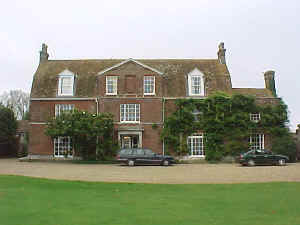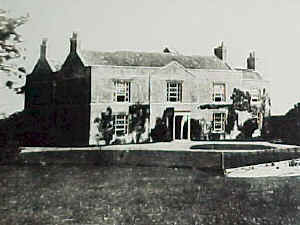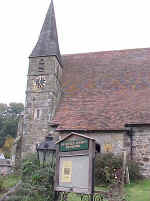Lossenham at Newenden, Kent
Lossenham
History
The Auchers of Lossenham in Newenden were descendants
of the Dukes of Kent. Anne, only daughter and heir of Henry
Aucher, carried the manor of Lossenham in marriage (circa 1490) to
Walter Culpeper9 of Wigsell and Under Marshall of
Calais. From this union descended the Hollingbourne
and the Wigsell branches of the family. (Source: Hasted, History
of Kent)
After Walter died in 1515 and his
wife Ann in 1532, their heir was their son William
Culpeper,
Esq.10. Upon William's death in 1559, his heir was
his son, John Culpeper, Esq.11. John died in Oct
1612, and his widow Elizabeth continued to live at Lossenham until her death in May 1618. Her son Thomas12 was to
be the heir, but on 18 Sep 1613 he predeceased her, leaving
Thomas' son, Slaney13 as heir. In Dec 1618, Slaney
died unmarried six months after the death of his grandmother, Elizabeth, and Slaney's heir was his brother John Culpeper of
Wigsell13. Lossenham was sold
in 1628 by John, who later
became Lord Culpeper, First Baron of Thoresway. (Sources:
Hasted, and other records in the Culpepper Connections!
Family Tree and Web site)
|

Lossenham at Newenden
Photograph by
Warren Culpepper, Oct. 1999

Lossenham at Newenden
19th Century
Location: 0.5 mile E of Newenden on Lossenham Lane.
National Grid Coordinates: TQ 841 277
|
|
Lossenham Dates, Culpeper Ownership and Monarch
 |
1200s-1490: Aucher family |
 |
1490-1516: Walter Culpeper9 of
Wigsell and Under Marshall of Calais *
(Henry VII, Henry VIII) (See Will) |
 |
1516-1532: Ann Culpeper, dowager of Walter
* (See Will)
(Henry VIII) |
 |
1532-1559: William Culpeper, Esq.10 *
(Henry VIII, Edward VI, Mary, and Elizabeth. When
Henry VIII seized the monasteries in 1536, William came into
possession of that land to restore to his Lossenham estate.)
(See Will) |
 |
1559-1612: John Culpeper, Esq.11 *
(Elizabeth, James I) |
 |
1612-1618: Elizabeth Culpeper, dowager of
John *
(James I) |
 |
1618-1628: John Culpeper of Wigsell13,
later Lord Culpeper, First Baron of Thoresway
(James I, Charles I) |
 |
1628-1742: Adrian Moore and descendants
(Charles I, the Commonwealth, the Stuarts) |
 |
1742: Bishop Family
(George II) |
 |
Later: Selmes and Tukes families |
 |
1999: Gethin family. |
* From 1490-1618, Lossenham Manor was held by
direct ancestors of the modern-day Culpeppers. These names are
in bold.
It is interesting to note that
the current owner of Lossenham is a descendant of the family of
Dame Grace Gethin. Dame Grace is the 4-great granddaughter of
William Culpeper, Esq.10, who owned the home from
1532-1559. Grace is honored on identical monuments at Hollingbourne
Church, where she is buried, and at Westminster
Abbey. The inscriptions reads, in
part:
To
the pious memory of Dame Grace Gethin, wife of Sir Richard
Gethin of Gethin Grott in Ireland, Baronet, Daughter of Sir
George Norton and Granddaughter of Sir George Norton, Knights,
and great granddaughter of Sir William Owen of Salop, Sir
Thomas Freak of Dorset and Sir Thomas Culpeper of Kent,
Knights. (Died) 11 Oct 1697 at age 21.
An
anniversary sermon is preached in Grace's memory in the Abbey
every Ash Wednesday.
|
Lands in Newenden
Sir
Thomas Culpeper6 will of 1428: "Touching the lands in Hernden in Sandherst
and Newynden..."
This could not have been Lossenham of Newenden as
the Culpepers had no yet come in possession of it. |
 Church
of St. Peter at Newenden Church
of St. Peter at Newenden
"The name Lossenham itself has an
important story to tell, for here Sir Thomas Fitz-Aucher founded
in 1242 one of the earliest Carmelite houses in England, and
dedicated it to the Blessed Virgin... Little trace of the Lossenham
mediaeval buildings has been discovered, except for
some of the stones built into the oast house, but many
significant field names survive, in Friar's Field, Friar's
Marsh, Kitchen orchard and Chapel Orchard. Most of the buildings
disappeared soon after the Dissolution of the Monasteries
(1536), but some must have been left standing, for Henry VIII
let the site to William Culpeper of Hunton."
Culpepper
Connections note: This was William Culpeper Esq.10,
a direct ancestor of the modern-day Culpeppers. Apparently, Sir
Thomas Fitz-Aucher had given only part of his land at Lossenham to the monastery, and the
Dissolution resulted in all of
Lossenham again being privately held.
Mention is made of
"all houses, buildings and lands lying within the site of
this house." In 1628, Sir John Culpeper (of Wigsell13) sold the estate to Adrian
Moore who built the new house. One of the Bishop family bought
it in 1742 and then it went to the Selmes and Tukes...
"...No mention of parochial records would
be complete without reference to the church's benefactor, King
Edward I. He came to Newenden to hunt and fish and it is
tradition that he stayed at Lossenham with the Fitz-Auchers, one
of whom was a Gentleman of the Bedchamber. It is interesting to
recall that the earliest reference to cricket is contained in
the wardrobe accounts of King Edward I when he stayed at Lossenham, and played there."
Source: Church booklet by Anne Roper, 4th
edition, June 1993.
Location: On A268 and A28, just north of
the River Rother, 11
miles SE of Goudhurst.
National Grid Coordinates: TQ 835 273 |
Newenden
History
and Photographs
1831 Topographical Dictionary
"NEWENDEN-LIBERTY. A parish in the hundred
of SELBRITTENDEN, lathe of SCRAY, county of KENT, 5˝ miles
(S.W. by S.) from Tenterden, containing 151 inhabitants... The church is
dedicated to St. Peter. This place, now an inconsiderable
village, but still governed by a bailiff and under-bailiff,
independent of the hundred, was formerly a large city and
sea-port, and is said to have contained fifty-two taverns. The
Roman station Anderid has by some been fixed near this spot,
where [p.362] large remains of earthworks, many Roman coins,
foundations, and other antiquities have been from time to time
discovered. The river Rother, which is crossed by a modern brick
bridge of three arches, on the high road from Kent to Sussex,
runs through the parish. At Losenden (Lossenham) are the remains of a Carmelite
friary, founded in 1241, by Sir Thomas Fitz-Aucher, Knight, in
honour of the Blessed Virgin. Here is a powerful chalybeate
spring."
|
|
Last Revised: 02 Jan 2015
|
|